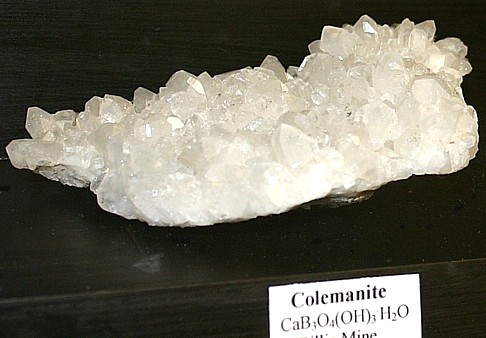|
.
Colemanite
Mineral Facts:
Chemical
Formula: Ca2B6O11-5H2O
Hydrous borate of
calcium.
Colors:
Colorless to white.
Hardness:
4
to 4.5
Density:
2.42
Cleavage:
One perfect clevage
parallel to 010, and less
perfect parallel to 001.
Crystallography: Monoclinic
Short prismatic
crystals, highly modified. The crystals are usually rich in forms. Also
massive to granular and compact.
Luster:.
vitreous or adamantine luster.
Optics:
(Refractive Index):
b= 1.5920
|
 |
|
Composition, Structure and
Associated Minerals:
Colemanite is a
rare mineral,
but occurring in considerable quantity in certain salt lake deposits, in the
arid regions of southeastern California, such as in Death Valley, Inyo
County, and in San Bernardino and Los Angeles counties. The mineral occurs
as indefinite layers
interstratified with shale and limestones that are associated with basalt.
The rocks contain layers and nodules of colemanite.
Gypsum
is often
associated with the borate and in some places is in excess. The colemanite
is believed to be the result of the action of emanations from the basalt
upon the limestone.
Identification
and Diagnostics
Before the blowpipe it decrepitates, exfoliates, and partially fuses, at the
same time coloring the flame yellowish green.
Fusible at 1.5. Yields water in closed tube. It is soluble in hot HC1, but
from the solution upon cooling a voluminous mass of boric acid separates as
a white gelatinous precipitate. It is easily distinguished from other white
translucent minerals, except those containing boron, by the flame test in
which it gives a green flame (positive test for boron). It is distinguished
from
borax by its insolubility in water and from boracite by its inferior
hardness and crystallization.
Localities
Colemanite occurs in Death Valley, California, near Daggett, San Bernardino
County, and near Lang Station, Los Angeles County, and at other points in
the same State, and in western Nevada, near Death Valley. A snow-white,
chalky variety (priceite) has been found in Curry County, Oregon, and a
compact nodular variety (pandermite) at the Sea of Marmora, and at various
points in Asia Minor.
Colemanite is an important
source of the element boron and its salts. The crude colemanite ore material
as mined contains from 5 per cent to 35 per cent of anhydrous boric acid.
This is crushed and roasted to extract the borates. The colemanite breaks
into a white powder which is separated from pieces of rock and other
impurities by screening, and then is bagged and shipped to the refineries
where it is manufactured into borax and boracic acid. The principal mines
producing the mineral were situated in the Death Valley section of Inyo
County, near Lang
Station in Los Angeles County, California, and in Ventura County in the same
State.
.Return
to the
Mineral Collectors Information Page |
|


